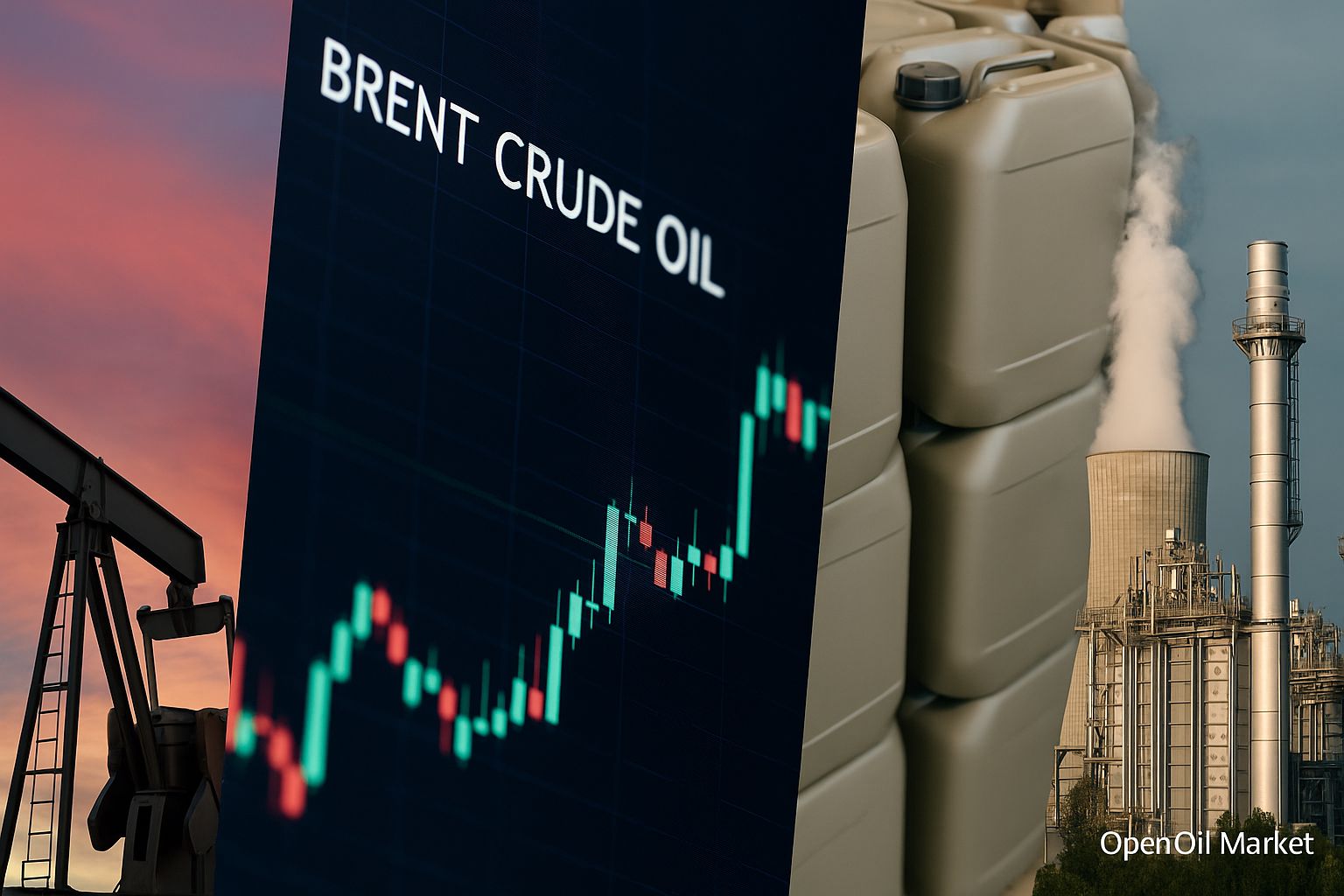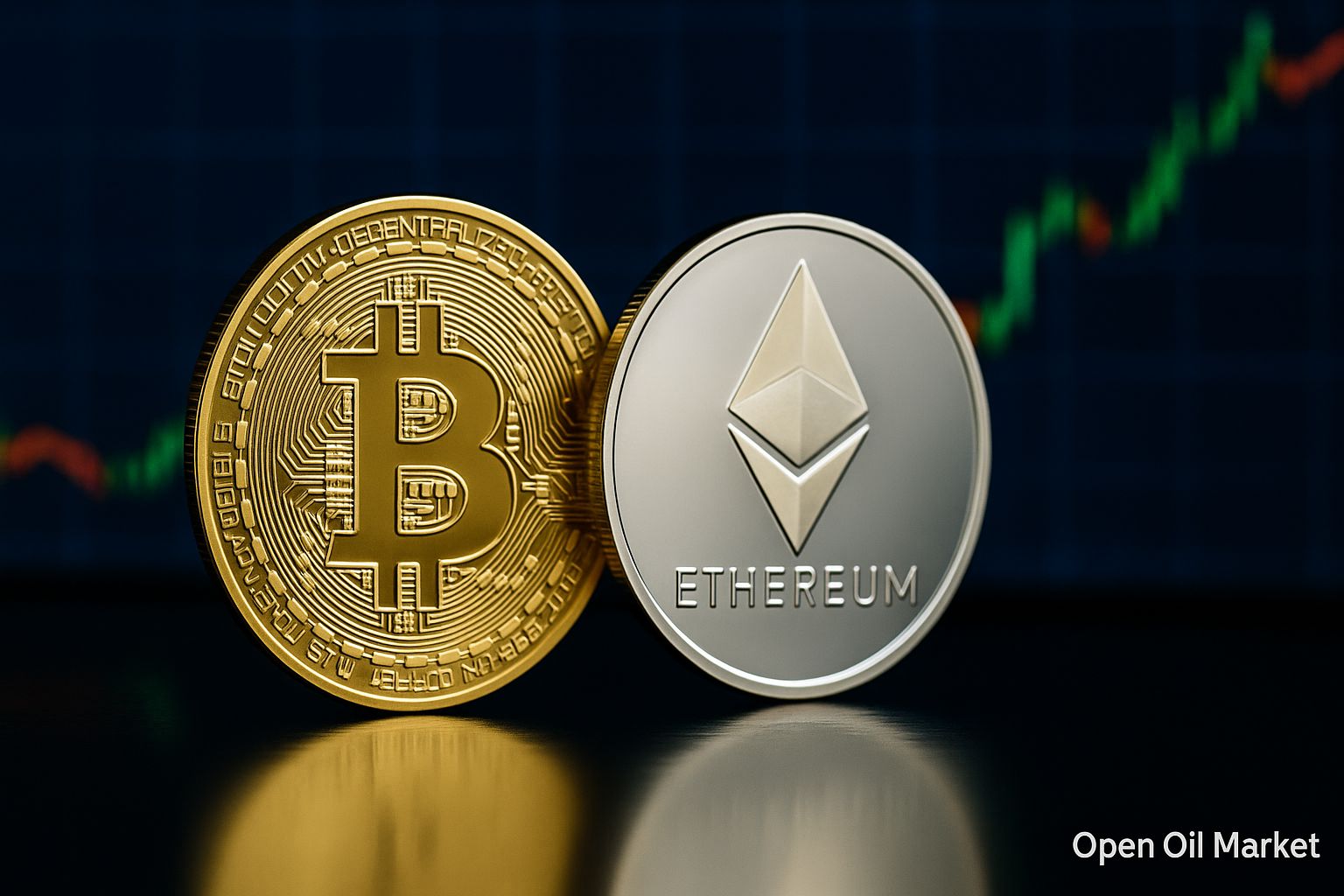
Current News in the Fuel and Energy Sector as of August 12, 2025: Sanction Standoff Between the US and India, Additional Oil Discount for New Delhi, Stabilization of Brent Prices Around $67, Continued Fuel Export Ban in Russia, Increase in Gas Stocks in Europe, Acceleration of Investments in Renewable Energy Sources.
The latest developments in the fuel and energy sector as of August 12, 2025, again attract the keen attention of investors and the market. The sanctions standoff between Washington and New Delhi is reaching a new phase—India is negotiating for more favorable supply conditions and has received an additional discount on Russian oil in response to US pressure. Against this backdrop, global oil prices, after a recent decline, are consolidating in the mid-$60s per barrel, demonstrating cautious stabilization around the $66–67 per barrel mark for Brent crude. In Russia, the export ban on gasoline and diesel, introduced to saturate the domestic market, remains in effect, which, combined with budget subsidies, is curbing the rapid rise in fuel prices. At the same time, Europe is rapidly increasing natural gas reserves ahead of the heating season, filling storage facilities significantly faster than last year's schedule. Despite the global push towards energy transition, short-term realities require balancing between the development of renewable energy sources and the use of traditional resources. Below are detailed accounts of key news in the commodities and energy sectors.
Washington Intensifies Sanction Pressures
Western coalition countries continue to escalate sanctions pressures aimed at limiting Russia's revenues from energy resource exports. Following a recent decision by allies to lower the price cap on Russian oil from $60 to $47.6 per barrel, the US is signaling its readiness for further measures. The American administration has increased monitoring of sanction implementations and is considering additional restrictions on buyers of Russian hydrocarbons. US President Donald Trump already imposed an additional 25% import tariff on Indian goods on August 6 due to New Delhi's continued purchases of Russian oil—this surcharge has doubled the overall tariff on Indian exports to 50%. Now, Washington is openly discussing the possibility of expanding similar measures to other Asian countries; earlier, the US Treasury warned of hypothetical tariffs up to 100% on Chinese exports if Beijing does not reduce its import of Russian oil. The tough rhetoric and intensifying restrictions from the West maintain high geopolitical tension in the global energy resources market, forcing oil traders and processors to account for new risks when planning deliveries.
India and China Advocate for Their Interests
Major Asian consumers of Russian raw materials are demonstrating their willingness to defend their economic interests despite external pressures. New Delhi publicly asserts that importing oil from Russia is vital for the country’s energy security and has no intention of sharply reducing it. Moreover, the Indian leadership has engaged in a form of trade bargaining: according to Reuters, India has expressed willingness to reduce the share of Russian supplies and conclude deals with other countries (including the US) only conditionally on comparable acceptable prices for energy resources being offered. Essentially, India has signaled that compensating for the cessation of cheap Russian oil without incurring economic losses will be challenging. In confirmation of this, India's state bank has estimated that a complete cessation of oil imports from Russia would cost the country approximately $9 billion in the current fiscal year and up to $12 billion in the next—enormous additional expenses for the economy.
Moscow has promptly responded to the situation, offering New Delhi an additional price concession to retain the market. Russian companies, according to Reuters, are ready to provide India with a discount of around $5 per barrel off the indicative price of Urals relative to the benchmark Dated Brent. Analysts from Kpler estimate that this concession has become a necessary measure amid tightening European Union sanctions and threats of new restrictions from the US—by conceding, suppliers aim to retain Indian demand and minimize the risk of losing the market. Concurrently, India has also demonstrated political determination: the Indian delegation canceled a planned visit to the US, during which a substantial arms contract was supposed to be signed. This move was somewhat of a response from New Delhi to the sanctions pressure, indicating its readiness to make sacrifices in the defense sector to maintain advantageous energy ties with Russia. Regarding Beijing, China has similarly made it clear that it does not intend to succumb to unilateral dictation: the Chinese Foreign Ministry has stated that coercive policies will yield no results and that the country will continue to purchase energy resources based on its sovereign interests. Thus, attempts by Washington to reshape global oil flows encounter staunch resistance from key Asian powers.
The Oil Market: Prices Consolidate Around $66–67 per Barrel
After several weeks of decline, global oil prices have managed to stabilize and even partially recover position. By mid-August, pricing for the benchmark Brent crude is trading in a relatively narrow range in the mid-$60s—around $66–67 per barrel, while American oil WTI remains around $64 per barrel. The improvement in market sentiment was influenced by several factors. Firstly, data from the US Department of Energy last week recorded an unexpected decrease in commercial oil inventories of approximately 3 million barrels, signaling robust demand and boosting market optimism. Secondly, market participants continue to closely monitor the development of the sanctions situation: ironically, US trade restrictions against India have led to a local price increase, as traders factor in the forecasted potential redistribution of oil flows and associated supply risks. Nevertheless, the potential for significant price increases remains limited. The proactive policy of OPEC+ regarding production increases has already been factored into the market: through gradual quota increases from April to September, additional oil volumes are cooling price dynamics. Additionally, concerns over a slowing global economy and demand in China are tempering price rallies. A range of analysts have revised oil price forecasts downward: it is expected that in the fourth quarter of 2025, the average Brent price may remain around $60–65 per barrel with no sign of a new price surge.
Sergey Tereshkin (expert commentary for RBC): “Due to the slowdown in the global economy, the $70 per barrel threshold will become critical for Brent prices in the remaining months of 2025.”
OPEC+ Maintains Production Balance
OPEC+ member countries adhere to a coordinated approach for cautious oil production increases, attempting to avoid market imbalance. In early August, key participants of the agreement, including Saudi Arabia, Russia, the UAE, and others, confirmed their intention to implement a previously announced increase in the total production quota by 547,000 barrels per day starting September 2025. Practically, this means an early phase-out of the voluntary restrictions imposed back in late 2023 to support the market: due to monthly increases in production from April to August and the upcoming increase in September, the alliance will remove the lion’s share of previous cuts nearly a year ahead of the original schedule. The market has responded relatively calmly to these actions, as they were anticipated and already priced in. Additional barrels are entering the market amid persistent geopolitical uncertainty, thus their impact on prices has been tempered. Within OPEC+, it is emphasized that the alliance aims to regain lost market shares without allowing for price collapses. Further steps by the cartel will be discussed on September 7 at a meeting of the Joint Monitoring Committee, where ministers will evaluate market conditions and consider the fate of the remaining voluntary production restrictions of 1.65 million barrels per day (which are formally extended until the end of 2026). So far, the alliance displays unity and caution, responding to the recovery in demand with a steady increase in supply.
Russian Oil Product Market: Export Ban and Price Controls
The domestic fuel market in Russia continues to face extraordinary restrictions introduced to stabilize prices. From late July until August 31, a complete ban on the export of certain oil products (primarily automotive gasoline) remains in effect for all producers and traders. These measures are designed to redirect maximum volumes of fuel to the domestic market and curb price increases at gas stations. According to the Moscow Fuel Association, the average retail price of AI-92 gasoline in Moscow had reached approximately 59 rubles/liter by early August, while AI-95 was around 65 rubles/liter, significantly higher than early-year levels. Despite the export ban, fuel prices at gas stations still continue to rise slowly, although the pace of increase has noticeably slowed compared to the frenzied spike in June.
To maintain price stability, the government is deploying significant budget resources. Oil refineries are receiving compensation through a damping mechanism—subsidies designed to soften the gap between high global oil product prices and relatively fixed domestic prices. In July 2025, the volume of payments for the fuel damping mechanism was around 60 billion rubles, which has indeed helped curtail sharper price increases for end consumers. However, expenses related to this mechanism are becoming more burdensome for the federal budget, especially as hydrocarbon revenues are declining: according to the Russian Ministry of Finance, in July, revenues from oil and gas exports amounted to about 787 billion rubles, falling short of planned values for the third consecutive month. Against the backdrop of declining export revenues, the government is discussing the possibility of adjusting or temporarily suspending the damping mechanism if global oil prices and exchange rates continue to negatively impact exporters' revenues. Specifically, this involves revisiting the calculation parameters for subsidies to reduce the budget burden while maintaining acceptable prices for fuel in the domestic market.
Open Oil Market Comment: “In July 2025, payments for the damping mechanism decreased by 58% compared to July 2024 (down to 59.9 billion rubles),” note analysts from the Open Oil Market platform. “Oil companies have no choice but to raise prices in segments of the market that are not covered by subsidies. These include, for example, free exchange prices for AI-95 gasoline that are not taken into account when calculating the damping mechanism, as well as prices in the over-the-counter wholesale market.”
Subscribe to the Open Oil Market Telegram channel for daily analysis of the fuel market.
Therefore, authorities and market participants must balance between restraining prices for consumers and maintaining the profitability of the fuel business. Wholesale prices for oil products continue to set new highs: exchange quotations for AI-95 gasoline at the Saint Petersburg International Commodity Exchange approach a record 80,000 rubles/ton, while AI-92 is nearing approximately 70,000 rubles/ton (the record for AI-92 stands at 70,500 rubles/ton, achieved in September 2023). Companies are forced to raise prices specifically in these segments to compensate for lost export revenues, while retail prices are subject to stricter regulation. The market is awaiting regulatory decisions: any changes in tax policy or subsidies could significantly impact the financial stability of refineries and fuel operators.
Gas Sector: Europe Accumulates Reserves Ahead of Winter
The European gas market is approaching the autumn-winter period with strong fuel reserves and diversified supply routes. As of early August, underground gas storage (UGS) facilities in the EU are filled to more than 72% of total capacity, exceeding average figures from previous years. According to Gas Infrastructure Europe, by August 9, reserves exceeded 76.7 billion cubic meters (about 71.6% of capacity) and continue to increase at an accelerated pace—Europeans have injected over 40 billion cubic meters of gas during this summer's storage replenishment season. EU countries aim to achieve a target level of approximately 90% by November 1, and current dynamics indicate a high likelihood of exceeding the planned reserves. High levels of reserves and a steady influx of liquefied natural gas (LNG) from alternative sources provide relative price stabilization: summer quotations at the TTF hub are holding in the $320–350 per thousand cubic meters range, significantly lower than the crisis peaks of 2022.
The energy map of Europe has changed significantly in recent years. Supplies of Russian pipeline gas through Ukraine have practically ceased (after contracts were completed in early 2025), and routes through the Baltic and Poland are also non-functional (“Nord Stream” and “Yamal–Europe” have been halted due to sabotage and sanction disagreements). In this context, the southern route remains the primary channel for receiving Russian gas in the EU (the “Turkish Stream” pipeline through Turkey and the Balkans), transporting about 50 million cubic meters per day—only a fraction of previous volumes from Russia. Europe is compensating for the lost niche with record LNG imports: the share of liquefied gas in the European balance has reached an all-time high. LNG reception terminals in EU countries are operating at high capacity, actively receiving supplies from the US, Qatar, Africa, and other regions. For instance, in just July 2025, Europeans imported about 11.3 billion cubic meters of gas in the form of LNG (37% more than the previous year), which helped offset the reduction in pipeline flows. Thanks to such diversification of sources and the accumulation of reserves, Europe is entering winter better prepared than last year. Nevertheless, potential risks remain—from possible extreme cold that could sharply increase demand to competition with Asian buyers for the next batches of LNG. European regulators and energy companies continue to closely monitor the situation, increasing reserves and strengthening infrastructure to guarantee energy security in the coming months.
Renewable Energy and Energy Transition: Records and New Investments
The global transition to clean energy is gaining momentum, setting new records. According to industry reviews, in 2024, the share of solar and wind generation in Europe for the first time surpassed electricity generation from coal and gas, indicating rapid progress in the development of renewable energy sources (RES). In the first half of 2025, fossil fuel energy production in the EU fell by 17% compared to the previous year, while generation from solar and wind installations reached record levels. Similar dynamics are observed globally: investments in renewable energy continue to grow at double-digit rates. According to the International Energy Agency, in 2025, total investments in the global energy sector are expected to exceed $3 trillion, with more than half of this amount directed to "green" energy. Specifically, investments in solar energy (both industrial stations and household panels) could reach $450 billion this year. Countries in Asia and the Middle East have announced projects for the construction of new solar and wind farms, while leading economies in the EU and North America are stimulating the sector with subsidies and incentives under energy transition programs.
At the same time, market realities dictate the need to maintain the role of traditional resources in the energy balance. High prices for natural gas and periodic generation disruptions in RES are prompting several countries to temporarily increase output at coal and gas power plants to ensure reliable supply. For instance, in the US, after a prolonged decline, the share of coal has risen again: in the early months of 2025, approximately 25% of electricity was generated at coal-fired power plants, marking the highest level in recent years. In several Asian countries (China, India, Vietnam, etc.), demand for coal also remains high due to rapid economic growth and the need to reliably meet peak consumption periods. These facts underscore that the energy transition is a step-by-step process: alongside record investments in RES, the world will still rely on oil, gas, and coal for some time to ensure stable energy supply for industries and populations. Nonetheless, the long-term trend remains unchanged: each new year brings records for capacity added in renewable energy, increasing its share in the global energy balance.
Prospects for Investors and Market Participants in the Fuel and Energy Sector
The culmination of news at this moment reflects a multifaceted and dynamic picture of the global fuel and energy sector. Geopolitical factors—from US sanctions pressure on leading Asian economies to changes in OPEC+ deal conditions—create heightened uncertainty for businesses, forcing traders and companies to quickly adapt to new conditions. However, fundamental market trends indicate a gradual restoration of balance: oil prices have stabilized at relatively comfortable levels for consumers, while producers' efforts prevent the market from sharp fluctuations. The European energy sector is entering winter with record gas reserves, reducing the risks of shortages, while global investments are confidently moving towards clean energy, opening up new growth opportunities.
For investors in the fuel and energy sector, a period of reassessing risks and strategies is unfolding. On one hand, traditional oil and gas projects face geopolitical and regulatory challenges, with their margins being squeezed due to sanctions and domestic market subsidization. On the other hand, the shift towards renewable energy sources and new technologies creates promising niches for investment—from renewable generation to energy storage infrastructure and efficiency enhancements. In the short term, market attention is focused on the resolution of the sanctions dispute between the US and India, the effectiveness of measures to stabilize fuel prices in Russia, as well as on the further steps of OPEC+ and weather factors in the gas sector. Market participants must remain flexible and closely monitor the situation: the balance of supply and demand in the energy sector remains fragile, but timely adaptation to changes will enable them to capitalize on emerging trends, whether in the growth of the RES sector or the recovery of traditional industries.




